“Social Formation and Regional Identity in Medieval Telangana”, the National Seminar held at the premises of the University campus on 24th, 25th March, 2017 (1)
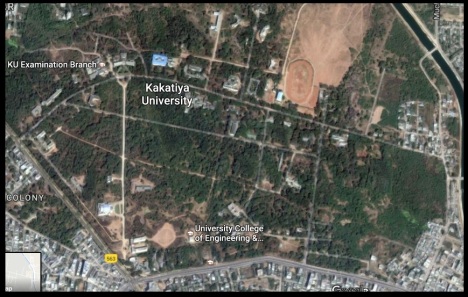
Location of Kakatiya University – Courtesy – GOOGLE Map.
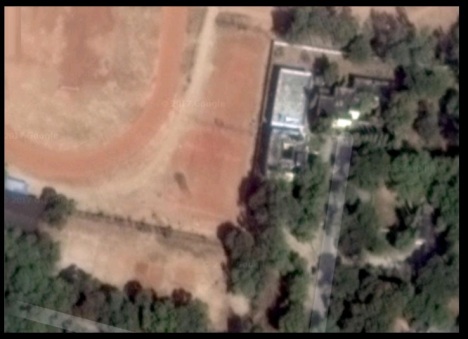
Location of Guest House – courtesy – Google map
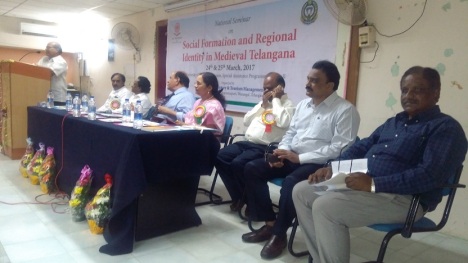
Inaugural function on 24-03-2017 – dias. M.V. Ranga Rao, Dayakar, Suryanarayana, Md Siddique, Varsha, Adapa Sathyanarayana, Ravindra Reddy, Srinath [L to R]
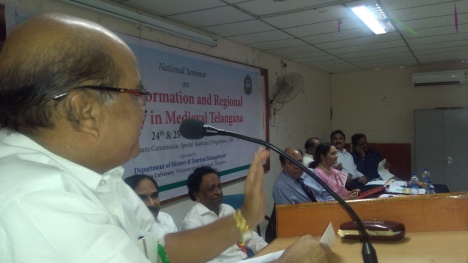
Registrar Ranga Rao invites all – Inaugural function on 24-03-2017 – dias.
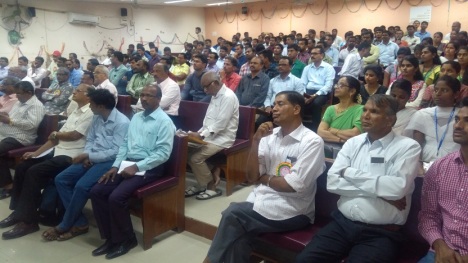
Inaugural function on 24-03-2017 – audience RHS.

Inaugural function on 24-03-2017 – audience RHS. Find the difference [I am here in this photo, but, not there in the above].
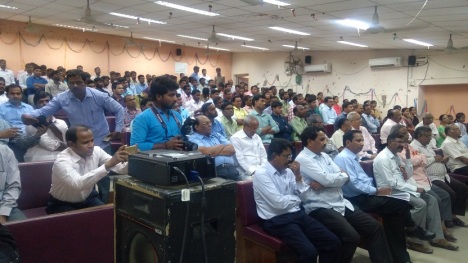
Inaugural function on 24-03-2017 – audience LHS.
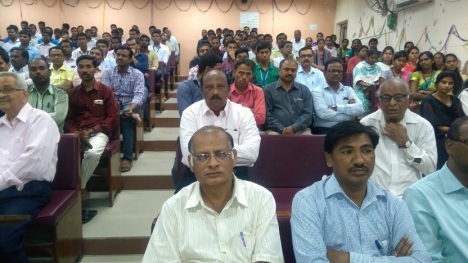
Inaugural function on 24-03-2017 – audience centre.
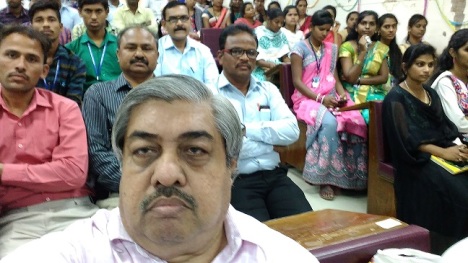
It is so-called selfie!!
Two day National Seminar on “Social Formation and Regional Identity in Medieval Telangana”: The Department of History and Tourism Management, Kakatiya University has conducted two day National Seminar under UGC SAP DRS -11 Program on “Social Formation and Regional Identity in Medieval Telangana” on 24th, 25th March, 2017 at the premises of the University campus. The science background people might be intriguing to note the expressions used SAP, DRS etc., that too, with the suffixes I, II etc. They are nothing but, SAP = Special Assistance Programme and not SAP SE or SAP [Systeme, Anwendungen, Produkte] as known[1] and DRS = Departmental Research Assistance and not anything else. Nowadays, it has become a trend to use scientific and technical expressions like social engineering, tension, stress, static, dynamic, hermetic, mobility, elevation, chemistry and so on and about which others might think in a different way. The paper presenters were selected based on the papers submitted and the papers had been of different aspects not overlapping and covering new facet of the subject matter. The delegates from various States Andhra, Karnataka, Tamilnadu, and New Delhi were accommodated in the guest house. The brochure given explained the purpose of the conference, the theme and the subject matter.
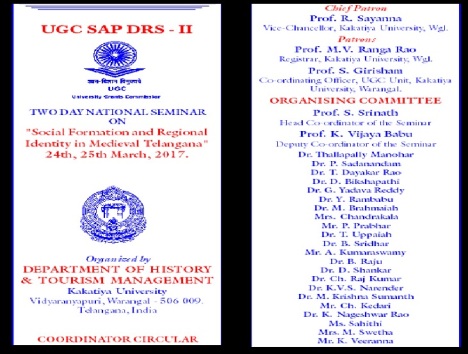
Telengana state formation and the trend of historigraphy[2]: The brochure says, “The formation of new State of Telangana on June 2nd 2014, as the 29th, has led to an intense debate, both among scholars and social groups, regarding its identity and distinctive socio-cultural formation[3]. The issue of Telangana has been a topic of public and intellectual debate for over six decades. The formation of new Telangana State has brought forward several issues and challenges. At the popular level, there has been a feeling that Telangana has become a melting pot and its identity has been undermined. Thus, it became a battle ground of contending socio-political forces. Attempts are being made to assert its distinctiveness and retrieve its past[4]. Articulation of difference has led to the rediscovery of history and culture of Telangana. The distinctiveness of Deccan cultural heritage, of which Telangana has been an integral part, formed basis for the demand of separate statehood both during the Pre and Post-independence periods[5]. Therefore, it is essential to examine the historical process of the emergence of modern Telangana and its distinct developmental trajectory and socio-economic transformation over a period of time.”
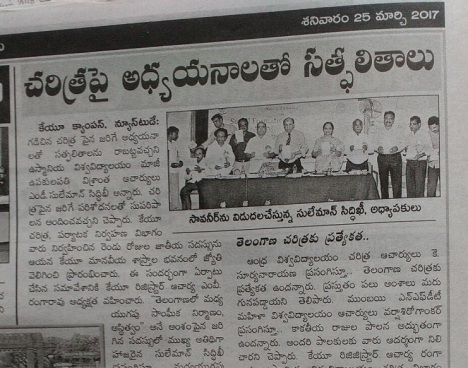
The non-Brahmin Sudra elites elevated under the Kakatiyas: It continues, “The Telangana regional identity formation has been traced to the Kakatiya period, as it witnessed politico-administrative unity and emergence of a distinct socio-cultural-religious formation. The Kakatiya polity was based on the Nayankara system consisting of the non-Brahmin Sudra elites, presently known as Velamas and Reddies. Under Kakatiyas, they served as soldiers, military chiefs and enjoyed local domination. The process of regional social formation in Telangana differed from the Indo-Gangetic Varna/jati model. Unlike the Dwijas, it was the dominant social groups of Chaturdakuljas, who played a significant role in state-society interface. In the socio-economic system, agrarian castes, pastoral communities, service castes, artisans, nomadic groups, menial castes were involved in the productive activities and social wealth. During and after the Kakatiya rule, the dominant Sudra gentry, established their supremacy over the settled communities of the region and established clusters of power and hierarchy of ranks and titles. Subsequently, they formed into a ruling aristocracy of powerful chiefs, who had established their control over the region. The rise of Velama/Padmanayaka and Reddi kingdoms is a case to study.”
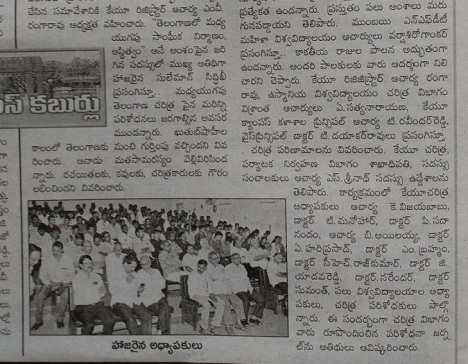
Formation of regional kingdoms of Telenganana[6]: It goes on to explain, “Historically the formation of regional kingdoms in medieval Telangana, viz., Rachakonda/Devarakonda was instrumental in the formation of state in locality and the constitution of hierarchy of power clusters and castes. The Golconda kingdom, under the Qutub Shahi rule pursued the process of consolidation of local gentry and ruling chiefs in pockets of their influence. Thus, regional political structure facilitated a sort of social engineering, supremacy and classification of caste groups into high and low with certain social norms, domination and subordination enforced from above. Nevertheless, in popular perception Telangana has become a symbol of people’s rebellion. Historical sources and folklore from the region contain several battles and insurgencies. The depiction of medieval rebels like Sarvai Papanna and others in medieval official chronicles as “bandits” is a clear proof. In the folklore and popular oral tradition rebels such as Sammakka/Saralamma, Papanna were celebrated as symbols of bravery and were respected as heroes and saviours of common people. It is observed that the historical process of interface between super-ordination and subordination in Telangana has not been adequately analysed by scholars.”
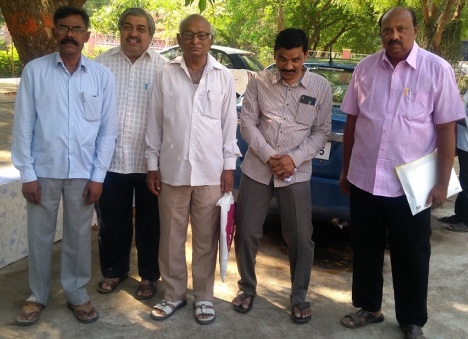
With Dr Sadanandam, [KVR], Dr Venkateswara Rao, DR T. Manohar and Dr Madhusudhana Rao.
The Sub-Themes of the Seminar: Besides the above, the sub-themes were also given for te benefit of the paper presenters. Although works by Cynthia Talbot, Parabrahma Sastry R.M Eaton and Philip Wagoner have outlined some aspects of the socio-political formation under the Kakatiya rule in Telangana, other aspects have also to be covered. Hence, this seminar will focus on the theme of regional social formation and its distinct characteristic features.
- Historical Geography, Polity and Administrative System.
- Regional Kingdoms in Medieval Telangana. Padmanayakas, Mudigonda and Vemulavada Chalukyas.
- Religion, Bhakti Movement and Sufism
- Social Formation and Social Structure,
- Economic Conditions, Agriculture, Trade and Commerce.
- Urbanisation Process
- History of Irrigation System in Telangana Region
- Literature, Folklore and Narratives
- Art and Architecture
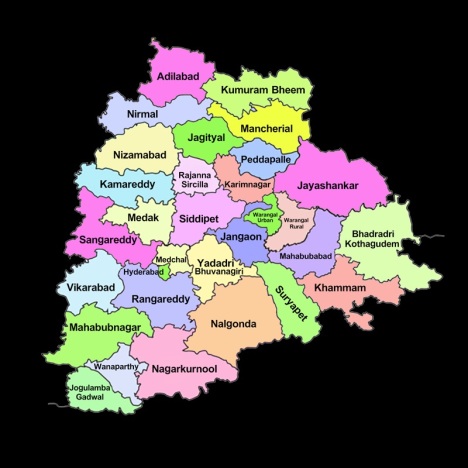
State symbols: Andhra Talli vs Telengana Talli: Though the state could declare the following four icons for the new State[7]:
- The State Bird – Palapitta (Indian Roller or Blue Jay).
- The State Animal – Jinka (Deer).
- The State Tree – Jammi Chettu (Prosopis Cineraria).
- The State Flower – Tangedu(Tanner’s Cassia),
it could not come to any consensus in the case of “Telengana Talli”[8]. The politics of “Andhra Talli” and “Telangana Talli” has been dealt with many researchers and shows only some sort of family feud in which children fighting for mother with each other[9]. Any sub-regional identity that hopes to gain strength in AP has to dismantle the idea of Telugu talli[10]. This realisation drove Telangana ideologues to invent the image of Telangana talli (mother of Telangana). Like other imagined mothers Telangana talli, constructed partly on fact and partly on myth. It has required romanticising the history of the kingdoms and kings that ruled the Telangana region, be they the Shatavahanas, Kakatiyas, Qutb Shahis, or the Nizams. There is no unanimity on how the feudal rule of the Nizams can be incorporated into constructing a regional identity. Others, especially left-oriented intellectuals such as Gaddar, prefer to invoke memories of the peasant rebellion against the Nizams to rouse the people to fight for a separate Telangana[11]. Making Telangana talli stand tall requires vilifying Telugu talli by interpreting the word “Andhra” to mean only the people of Seemandhra, and promoting the notion that Telugu is being used as a ruse by Seemandhra capitalists to fool the people of Telangana. In other words, the people have to know that the idea of unity of all Telugus is a myth invented by the Andhra people to justify their exploitation and oppression of the Telangana region (Srinivasulu 2012). Thus, it appears that no consensus has been reached in this regard[12].
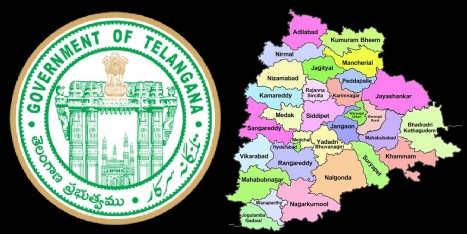
Inaguration and the speeches made by the invited scholars: As usual, the inauguration was delayed for the late arrival of the VIPs and thus, the program started by 10.40 am at the Seminar Hall, Humanities Building. The dignitaries on the dais were – Dr / Prof / HOD Dayakar Rao, Suryanarayana, Dept of History, Telugu University, Visakapatnam; M. V. Ranga Rao, the registrar, Mohammed Sulaimam Siddhiqu, VC, Osmania University; Varsha Shrirgaonkar, Prof & Head, Dept of History, SNDT Women’s University, Mumbai; Adapa Sathyanarayana Rao, Prof (Retd), Dept of History, Osmania University; T. Ravindra Reddy, Principal, University College, Kakatiya University. Interestingly, unlike other seminars / conferences, where the lamp-lighting marks the inauguration, here, that was not there. It is not known as to whether, it was purposefully avoided or made a point. As usual, the introduction of the guests, honouring them with bouquets, shawls and mementos and other routines went on. Then, each started speaking to render their eloquence delving upon the subject matter in their own way of expression and rendition. Obviously, some sort of ideology was revealed in their discourses.
11.40 – 12.00 Hrs: Prof Suryanarayana Rao in his key note address pointed out the origin of Telengana to Jains. The Jains were following the same “Varnashrama dharma” as that of Hindus, in fact, he quoted that “the Jaina Sudra was in no way better than Jaina Sudra”. Them, he delved upon the following points. The dancing girls of Telengana had right to dance in front of Lord Jagannatha in the Bogha Mantap. Then, he tried to trace the origin of the expression “Telengana” as used by Abdul Fazal, Al Beruni etc., during the medieval period. The enthno-linguistic group wanted to claim the status of “Telangana” asserting that “We are different from others”. As the people were engaged in different professions and vocations, the “Caturvarna” system was not required here and there was no “agrahara” culture here. Thus, the revival of “Ganges valley” type of Hinduism here would not come. No communal riot has been reported during the last 400 years rule. The Christian missionaries are responsible for the education and other related activities. Of there could have been conversion and people might have come from outside also. Thus, the outsiders (outside India) might constitute 5%. Here, the motto has been “intolerance to injustice”!
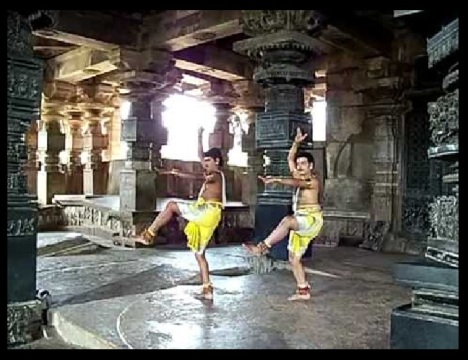
12.00 to 12.14 Hrs: Varsha S. Shirgaonkar, Prof & Head, History Department, SNDT women’s University, Mumbai stressed about the analyst method of historiography was required to deal with the issues connected in the context. Peshwa – II used to invite dancers from Telangana to Ganesh Cathurti festival celebrated there. She also mentioned about the decorated, designed cloth materials brought from the Telangana region. Actually, there is Perini Sivathandavam or Perini Thandavam form of dance, originated during the reign of Kakatiyas and revived in recent times in Telangana. Actually, it is a valour-type of dance, where, male dancers dance invoking Shiva before any battle. “Perini” is derived from “Prerana” = inspiration, that is, inspiration required for soldiers to fight. But, the examples given by above are about the dance by female members. This difference has to be noted.
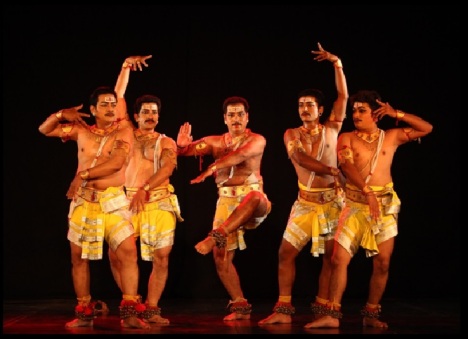
Perini Sivathandavam / Perini Thandavam.
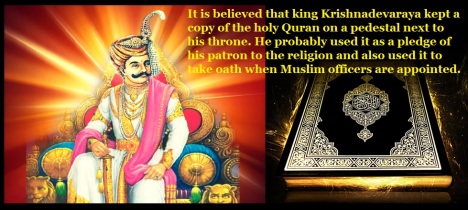
12.14 to 12.40 Hrs: Prof Mohammed Sulaimam Siddhique, former VC of Osmania University streesed the following points: The Muslims came to India had to be differentiated as they were Arabs, Turks, Afghan / Pathans and others. The Muslims came through north-east had been different from that of the South. The Poets of the Qutub Shah were well vered in the Vedas, Manu Smriti etc. The poets, Thoma Naidu and Malla Naidu had been the experts in Modi script. There were “moorish quarters” in the Krishnavedaraya Kingdom and there were about 68,000 Muslim soldiers in his army. It is believed that king Krishnadevaraya kept a copy of the holy Quran on a pedestal next to his throne. He probably used it as a pledge of his patron to the religion and also used it to take oath when Muslim officers are appointed. M.S. Siddhique pointed out that Veerasaiva priest used to perform the annual death rites of Adil Shah. In India, Dakhini Muslims trace their origin to Shias of Iran, whereas, Sunnis to Automan. And the Muslims of south are known as “Dakhini Muslims”, the northern ones known as “Hindustani Muslims”. After the inaugural session, the delegates had a typical “Andhra” Lunch, or “Telangana” Lunch with characteristic dishes of dhal (Pappu, Pulusu), vegetables, chutnies (colloidal mixture of vegetables and spices) and so on!
© K. V. Ramakrishna Rao
29-03-2017.
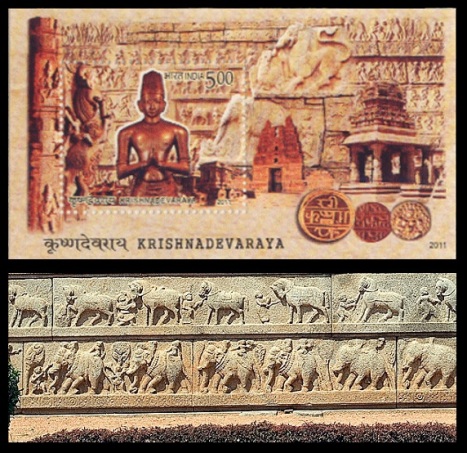
[1] SAP E, a global software company, is one of the largest vendors of ERP and other enterprise applications. The company is headquartered in Walldorf, Germany. SAP was started in 1972 by five former IBM employees in Mannheim, Germany. The original name for SAP, Systeme, Anwendungen, Produkte, is German for “Systems, Applications and Products.”
[2] As per the Circular distributed during the Anantpur session of APHC and amended later in March 2017 by the organizers.
[3] http://www.telangana.gov.in/
[4] ‘South of North and North of South,’ Telangana State has long been a meeting place for diverse languages and cultures. It is easily the best example for India’s composite culture, pluralism and inclusiveness. Located on the uplands of Deccan plateau, Telangana is the link between the North and South of India. It is thus no surprise that the region on the whole came to be known for its Ganga-Jamuna Tehzeeb and the capital Hyderabad as a ‘miniature India!’.
http://www.telangana.gov.in/About/Language-Culture
[5] Geography, Polity and Economy of the region determined the culture of Telangana. Satavahanas, the earliest known rulers of the region sowed the seeds of independent and self-sufficient village economy, the relics of which can be felt even today. In the medieval times, the Kakatiya dynasty’s rule, between the 11th and 14th centuries with Warangal as their capital, and subsequently the Qutub Shahis and Asafjahis, who ruled the Hyderabad state defined the culture of the region.
http://www.telangana.gov.in/About/Language-Culture
[6] The history is classified into the following periods – Pre-history (Up to 1000 BCE); Pre-Satavahanas (1000 BCE – 300 BCE); Satavahanas (250 BCE – 200 CE); Post-Satavahana (200 CE – 950 CE); Kakatiyas (950 CE – 1323 CE); Post-Kakatiya Interregnum (1323 – 1496); Qutbshahis (1496 – 1687); Asaf Jahis (1724-1948); Post-independence.http://www.telangana.gov.in/About/History
[7] http://www.telangana.gov.in/About/State-Symbols
[8] Srikanth, H. Construction and consolidation of the Telangana identity. in Economic and Political Weekly , Volume. 48, Nos.45-46 (2013): pp.39-45.
[9] Patra, Parichay. Srinivas, SV Politics as Performance: A Social History of the Telugu Cinema, pp.164-165.
[10] Kumar, Ashutosh, ed. Rethinking state politics in India: Regions within regions. Routledge, 2012.
[11] Gaddar and his team have many songs eulogising the peasants and youth who participated in the peasant struggles, Naxalite movement, and the Telanga.
[12]http://s3.amazonaws.com/academia.edu.documents/33840566/Construction_and_Consolidation_of_the_Telangana_Identity.pdf?AWSAccessKeyId=AKIAIWOWYYGZ2Y53UL3A&Expires=1490536231&Signature=VQPQMITKK5bVLm6eT%2Bupv4IfI6s%3D&response-content-disposition=inline%3B%20filename%3DConstruction_and_Consolidation_of_the_Te.pdf
Filed under: agrarian, andhra, archaeology, bifurcate, brahmin, cholas, civilization, colonial, commerce, conference, economics, ethnicity, heritage, historicity, history, hyderabad, jain, K. V. Ramakrishna Rao, linguistics, nation, nation building, nation-state, nationalism, nizam, non-brahmin, objectivity, politics, rajendra, reddy, regionalism, relations, relocate, renovation, secession, sedition, self-determination, tradition, vijayanagar | Tagged: Andhra, brahmin, caste, cate system, catur varna, dalit, dance, kakatiya, khastriya, perini, perini sivathandava, perini thandava, sudra, telangana, vaisya, varnashrama, warangal | Leave a comment »

